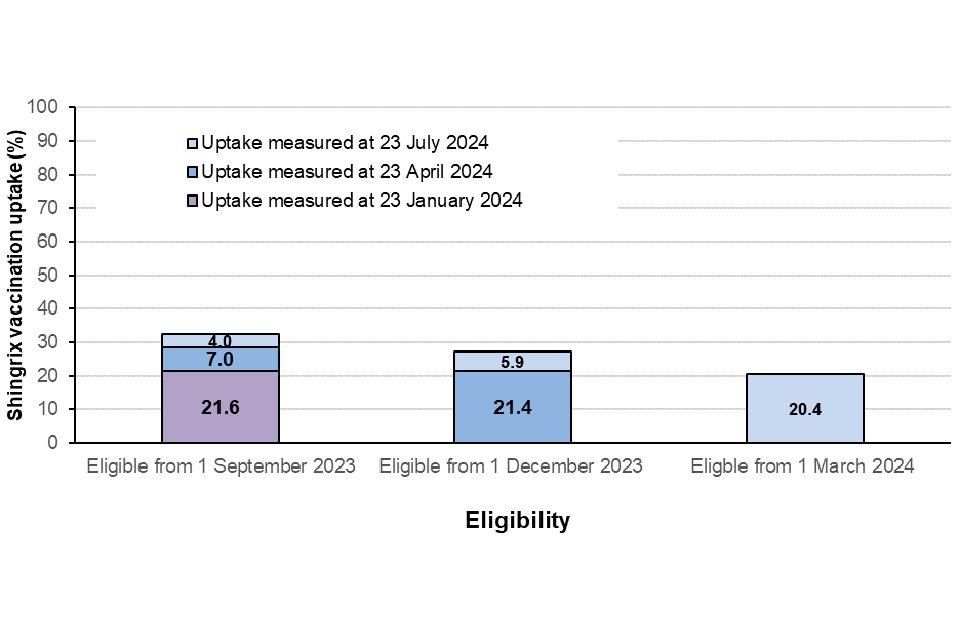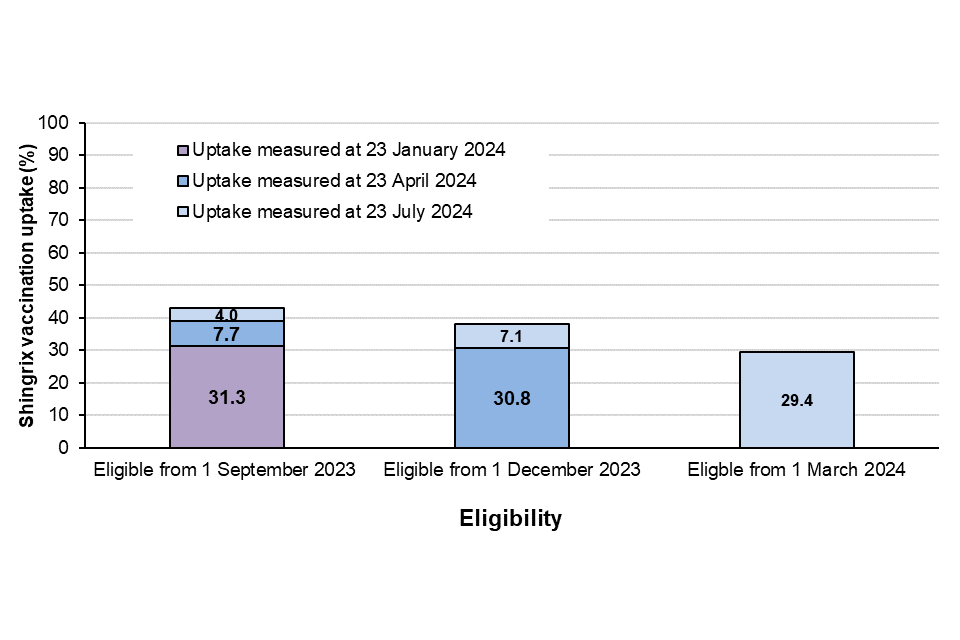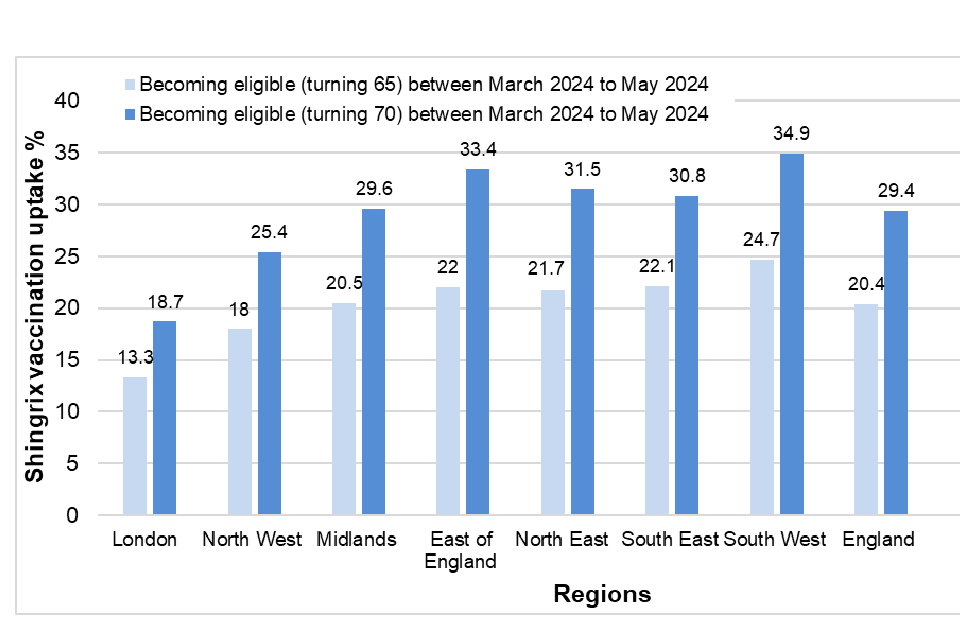Shingrix® vaccine uptake report (adults eligible from September 2023 to May 2024 and vaccinated to the end of July 2024): England
Updated 31 October 2025
Applies to England
Main points
The new Shingrix shingles immunisation programme commenced on 1 September 2023. In this report, vaccine uptake of the first dose is evaluated in those turning 70 and 65 years old in quarter 3 of academic year 2023/24 (1 March 2024 to 31 May 2024), assessed at 23 July 2024. Uptake is also updated for those who became eligible in quarters 1 and 2 (1 September 2023 to 29 February 2024), previously assessed at 23 April 2024 (1).
The new immunisation programme offers two doses of Shingrix vaccine to all immunocompetent individuals turning 65 and 70 years of age and to severely immunosuppressed individuals aged 50 years of age and over. Shingrix vaccine uptake is expected to increase when measured at the end of each quarter of the 2023/24 academic year, and in subsequent years, as individuals are vaccinated up to their 80th birthday.
The main findings were that:
- uptake in the cohort who turned 65 years old in quarter 3 of 2023/24 was 20.4% when measured at 23 July 2024
- uptake in the cohort who turned 65 years old in quarter 2 of 2023/24 was 27.3%, an increase of 5.9% since it was first measured at 23 April 2024
- uptake in the cohort who turned 65 years old in quarter 1 of 2023/24 was 32.6%, an increase of 11.0% since it was first measured at 23 April 2024
- uptake in the cohort who turned 70 years old in quarter 3 of 2023/24 was 29.4%, when measured at 23 July 2024
- uptake in the cohort who turned 70 years old in quarter 2 of 2023/24 was 37.9%, an increase of 7.1% since it was first measured at 23 April 2024
- uptake in the cohort who turned 70 years old in quarter 1 of 2023/24 was 43.0%, an increase of 11.7% since it was first measured at 23 January 2024
- vaccine uptake by NHS commissioning region was highest in South West (24.7%) and lowest in London (13.3%) in individuals turning 65 during quarter 3 (1 March 2024 to 31 May 2024)
- vaccine uptake by NHS commissioning region was highest in South West (34.9%) and lowest in London (18.7%) in individuals turning 70 during quarter 3 (1 March 2024 to 31 May 2024)
- vaccine uptake for all immunosuppressed patients aged 50 years and over was 16.8%
Introduction
The aim of the routine shingles (herpes zoster) vaccination programme is to prevent severe morbidity from shingles in groups at the highest risk.
A routine shingles vaccination programme began on 1 September 2013, offering one dose of the shingles vaccine (Zostavax) to all 70 year olds, together with a catch-up programme for older cohorts (1, 2, 3, 4).
Adults became eligible at 70 years of age and remained eligible until their 80th birthday (see the Appendix).
From September 2021, these two programmes ceased, being replaced by a new shingles recombinant sub-unit vaccine (Shingrix) (5) was added to the programme to increase protection against shingles (herpes zoster) amongst eligible cohorts unable to have the live Zostavax shingles vaccine due to immunosuppression or/and contraindication.
From 1 September 2023, these two programmes ceased, being replaced with a new programme offering two doses of Shingrix vaccine to:
- immunocompetent individuals turning 65 and 70 years of age, and
- all severely immunosuppressed individuals (eligibility as defined in the Green Book Shingles chapter 28a) from 50 years of age
Immunocompetent individuals will remain eligible for the Shingrix vaccine until their 80th birthday and vaccines will be offered in a phased implementation over a 10-year period. For full details on eligibility and the phased programme, see information for healthcare practitioners.
This quarterly report evaluates uptake of the first dose in those turning 70 and 65 years old during quarter 3 (1 March to 31 May 2024), assessed at 23 July 2024.:
It also provides updated measures of uptake in those who became eligible in previous quarters. That is:
- those turning 65 or 70 between 1 December 2023 and 29 February 2024 (quarter 2), first assessed at 23 April 2024, and
- those turning 65 or 70 between 1 September 2023 and 30 November 2023 (quarter 1), first assessed at 23 January 2024.
Methods
The uptake data presented in this report was collected at GP practice level and was automatically uploaded via participating GP IT suppliers to the ImmForm website each quarter of the September to August academic year. Data was then validated and analysed by UKHSA to check data completeness, identify and query any anomalous results and describe epidemiological trends.
Vaccine uptake was defined as the number of patients in each birth cohort who received the first dose of the Shingrix vaccine (numerator) as a proportion of the total number of registered patients in that birth cohort (denominator).
Quarter 3 vaccine uptake in the 65 and 70-year-old cohorts was defined as the percentage of the total number of patients turning 65 or 70 in quarter 3 (1 March 2024 to 31 May 2024) who had received the first dose 1 of Shingrix when assessed at 23 July 2024. By collecting the data in late July, those becoming eligible in quarter 3 had between 1 and 4 months to receive the vaccine, depending on their date of birth.
Quarter 2 vaccine uptake in the 65 and 70-year-old cohorts was defined as the percentage of the total number of patients turning 65 or 70 in quarter 2 (1 December 2023 to 29 February 2024) who had received dose 1 of Shingrix – assessed at 23 April 2024. As data was collected in late July, those becoming eligible in quarter 2 had between 5 and 7 months to receive the vaccine, depending on their date of birth.
Quarter 1 vaccine uptake in the 65 and 70-year-old cohort was defined as the percentage of the total number of patients turning 65 or 70 in quarter 1 (1 September 2023 to 30 November 2023) who had received the first dose of Shingrix when assessed at 23 July 2024. Where vaccination data was assessed in late July, those becoming eligible in quarter 1 had between 8 and 10 months to receive the vaccine, depending on their date of birth.
Uptake in these cohorts will be reassessed again in October 2024, when eligible individuals will have had between 5 and 13 months to have been vaccinated. Coverage will continue to be monitored while individuals are still eligible, until they reach their 80th birthday,
Uptake was assessed on a quarterly basis (1 March 2024 to 31 May 2024) in immunosuppressed individuals aged 50 years and over by 31 August 2024 (born prior to 1 September 1974). Some of those immunosuppressed individuals aged 71 and over will have previously been eligible for Shingrix which was offered to immunosuppressed patients, who were contraindicated to Zostavax, from 1 September 2021.
A more detailed breakdown of the different cohorts can be found in Table 1.
Table 1. Birth dates and Shingrix vaccine eligibility dates for routinely eligible cohorts assessed in the 2023 to 2024 academic year
| Birth date range of cohort | Year first eligible for the Shingrix vaccine | Age in September 2023 to August 2024 | Period first eligible for the Shingrix vaccine |
|---|---|---|---|
| 1 September 1953 to 31 August 1954 | 2023 to 2024 | 70 | 1 September 2023 to 31 August 2024 |
| 1 September 1958 to 31 August 1959 | 2023 to 2024 | 65 | 1 September 2023 to 31 August 2024 |
Results
A total of 6,146 out of a total of 6,324 (97.2%) GP practices reported Shingrix vaccine uptake data for the third quarter. The GP IT suppliers EMIS and TPP provided data.
Vaccine uptake for the birth cohort turning 65 in the 2023 to 2024 academic year
The third quarterly report of the academic year 2023/24 finds that:
- 20.4% of adults turning 65 during quarter 3 were vaccinated by 23 July 2024
- 27.3% of adults turning 65 during quarter 2 were vaccinated by 23 July 2024, an increase of 5.9% from when it was measured at 23 April 2024 (Figure 1)
- 32.6% of adults turning 65 during quarter 1 were vaccinated by 23 July 2024, an increase of 11.0% from when it was measured at 23 January 2024 (Figure 1)
Vaccine uptake varied by NHS commissioning regions and was the highest in the South West (24.7%) and lowest in London (13.3%), in individuals turning 65 during quarter 3 (1 March 2024 to 31 May 2024).
Vaccine uptake for the birth cohort turning 70 in the 2023/24 academic year
The third quarterly report of the academic year 2023 to 2024 finds that:
- 29.4% of adults turning 70 during quarter 3 were vaccinated by 23 July 2024
- 37.9% of adults turning 70 during quarter 2 were vaccinated by 23 July 2024, an increase of 7.1% from when it was measured at 23 April 2024 (Figure 2)
- 43.0% of adults turning 70 during quarter 1 were vaccinated by 23 July 2024, an increase of 11.7% from when it was measured at 23 January 2024 (Figure 2)
In quarter 3, uptake varied by commissioning region and was the highest in South West (34.9%) and lowest in London (18.7%), as shown in Figure 3.
Vaccine uptake for immuno-suppressed patients in the 2023 to 2024 academic year
In total, 148,407 of the total 885,657 (16.8%) of immunosuppressed patients eligible for Shingrix were recorded as having had received the first dose to 23 July 2024.
Uptake varied by commissioning region, and was the highest in North East and Yorkshire (18.2%) and lowest in London (12.4%) as shown in Figure 3.
Figure 1. Shingrix dose 1 vaccine uptake for cohorts turning 65 during quarter 1 (September 2023 to November 2023), quarter 2 (December 2023 to February 2024) and quarter 3 (March 2024 to May 2024) of the 2023 to 2024 academic year

Figure 2. Shingrix dose 1 vaccine uptake for cohorts turning 70 during quarter 1 (September 2023 to November 2023), quarter 2 (December 2023 to February 2024) and quarter 3 (March 2023 to May 2024) of the 2023 to 2024 academic year

Figure 3. Shingrix dose 1 vaccine uptake for cohorts turning 65 and 70 during quarter 3 of the 2023 to 2024 academic year, by NS commissioning region at 23 July 2024

Table 2. Shingrix dose 1 vaccine uptake for immunosuppressed patients (born before 31 August 1974) to 23 July 2024, by NHS commissioning region
| NHS commissioning region | Shingrix dose 1 coverage (%) |
|---|---|
| London | 12.4 |
| North West | 15.6 |
| Midlands | 16.8 |
| East of England | 17.5 |
| South East | 17.9 |
| South West | 18.1 |
| North East and Yorkshire | 18.2 |
| England | 16.8 |
Discussion
Shingrix vaccine uptake in the cohort who became eligible in quarter 3 was comparable to uptake measured for the previous quarters, while it increased in the routine 65 and 70-year-old cohorts who first became eligible for vaccination from September 2023 to February 2024, indicating the continued implementation of the Shingrix immunisation programme.
Uptake is expected to cumulatively increase as individuals have longer to be vaccinated. The lower uptake among both the 65 and 70-year-olds in quarter 3 (becoming eligible in March 2024 to May 2024) – compared to those who became eligible in the second (December 2023 to February 2024) and first (September to November 2023) quarters – is due to the eligibility criteria (5), as those becoming eligible in quarter 1 or quarter 2 had longer to be vaccinated when assessed at 23 July 2024.
Shingrix vaccine uptake is expected to increase when measured at the end of each quarter of the 2023/24 academic year, and in subsequent years, as individuals are vaccinated up to their 80th birthday.
Uptake of Shingrix vaccination in the third quarter of this first year of the programme is lower than the latest uptake achieved with the previous Zostavax shingles immunisation programme in 2022/23. In those who turned 70 in quarter 3, Shingrix uptake was 29.4% when measured after three quarters compared to 35.1% uptake achieved in 70 year olds measured after three quarters for Zostavax (6).
However, the time periods are not directly comparable, and the first two quarters of the Shingrix programme coincided with the seasonal influenza and COVID-19 immunisation programmes. Furthermore, the Shingrix immunisation programme targets an additional routine cohort (65 year olds).
Uptake is approximately 10% lower in the 65 year old cohort as compared to the 70 year old cohort.
Appendix. Dates and eligibility criteria for the shingles (Zostavax) vaccination programme since 1 September 2013
1 September 2023
The new Shingrix vaccination programme was introduced in September 2023. The new programme offers 2 doses of Shingrix vaccine to all severely immunosuppressed individuals from 50 years of age and immunocompetent individuals turning 65 and 70 years of age.
1 September 2020
As of 1 September 2020, all individuals in the catch-up cohorts (born 2 September 1933 to 1 September 1942) have been offered the shingles (Zostavax) vaccine as they became 78 years old, thus completing the catch-up programme which started on 1 September 2013.
1 April 2017
The eligibility criteria for receiving the shingles (Zostavax) vaccine was simplified so that individuals become eligible on their 70th birthday (routine cohort) or their 78th birthday (catch-up cohort).
1 September 2016
In the fourth year of the programme (1 September 2016 to 31 August 2017), the vaccine was routinely offered to adults aged 70 years on 1 September 2016 (born between 2 September 1945 and 1 September 1946). The fourth year of the programme also included a catch-up cohort of adults aged 78 on 1 September 2016 (born between 2 September 1937 and 1 September 1938). In addition, patients who became eligible in the first 3 years of the programme but had not been vaccinated against shingles remained eligible until their 80th birthday (patients aged 71, 72, 73 and 79 on 1 September 2016).
1 September 2015
In the third year of the programme (1 September 2015 to 31 August 2016), the vaccine was routinely offered to adults aged 70 years on 1 September 2015 (born between 2 September 1944 and 1 September 1945). The third year of the programme also included a catch-up cohort of adults aged 78 on 1 September 2015 (born between 2 September 1936 and 1 September 1937). In addition, patients who became eligible in the first 2 years of the programme but have not been vaccinated against shingles (Zostavax) remain eligible until their 80th birthday (patients aged 71, 72 and 79 on 1 September 2015).
1 September 2014
In the second year of the programme (1 September 2014 to 31 August 2015), the vaccine was routinely offered to adults aged 70 years on 1 September 2014 (born between 2 September 1943 and 1 September 1944). The second year of the programme also included 2 catch-up cohorts comprised of adults aged 78 on 1 September 2014 (born between 2 September 1935 and 1 September 1936), and adults aged 79 on 1 September 2014 (born between 2 September 1934 and 1 September 1935). In addition, those who became eligible as 70 year olds from 1 September 2013 but had not yet been immunised were also eligible.
1 September 2013
In the first year of the programme (2013 to 2014), the vaccine was routinely offered to adults aged 70 years on 1 September 2013 (born between 2 September 1942 and 1 September 1943 and to adults aged 79 on 1 September 2013 (born between 2 September 1933 and 1 September 1934) as part of the catch-up campaign.
References
1. Shingles immunisation programme [Shingrix®]: evaluation reports
2. NHS Choices website (2021). Who can have the shingles vaccine?
3. UKHSA (2022). Vaccination against shingles: information for healthcare professionals
4. UKHSA (2022). Shingles: guidance and vaccination programme
5. UKHSA. Shingles (herpes zoster): the Green Book, chapter 28a
6. UKHSA (2024) Shingles vaccine coverage (England): report for quarter 3 of the financial year 2022 to 2023
